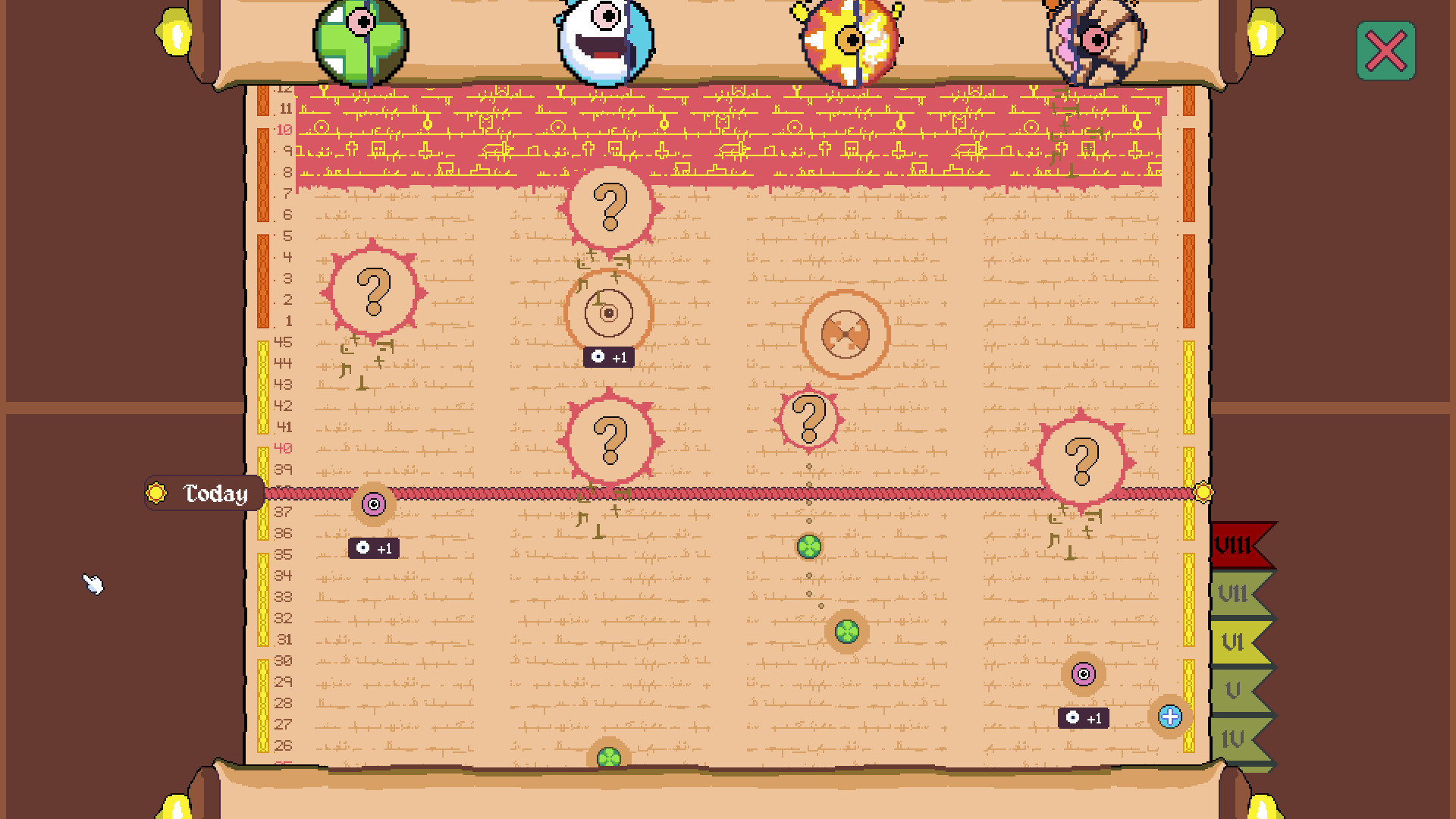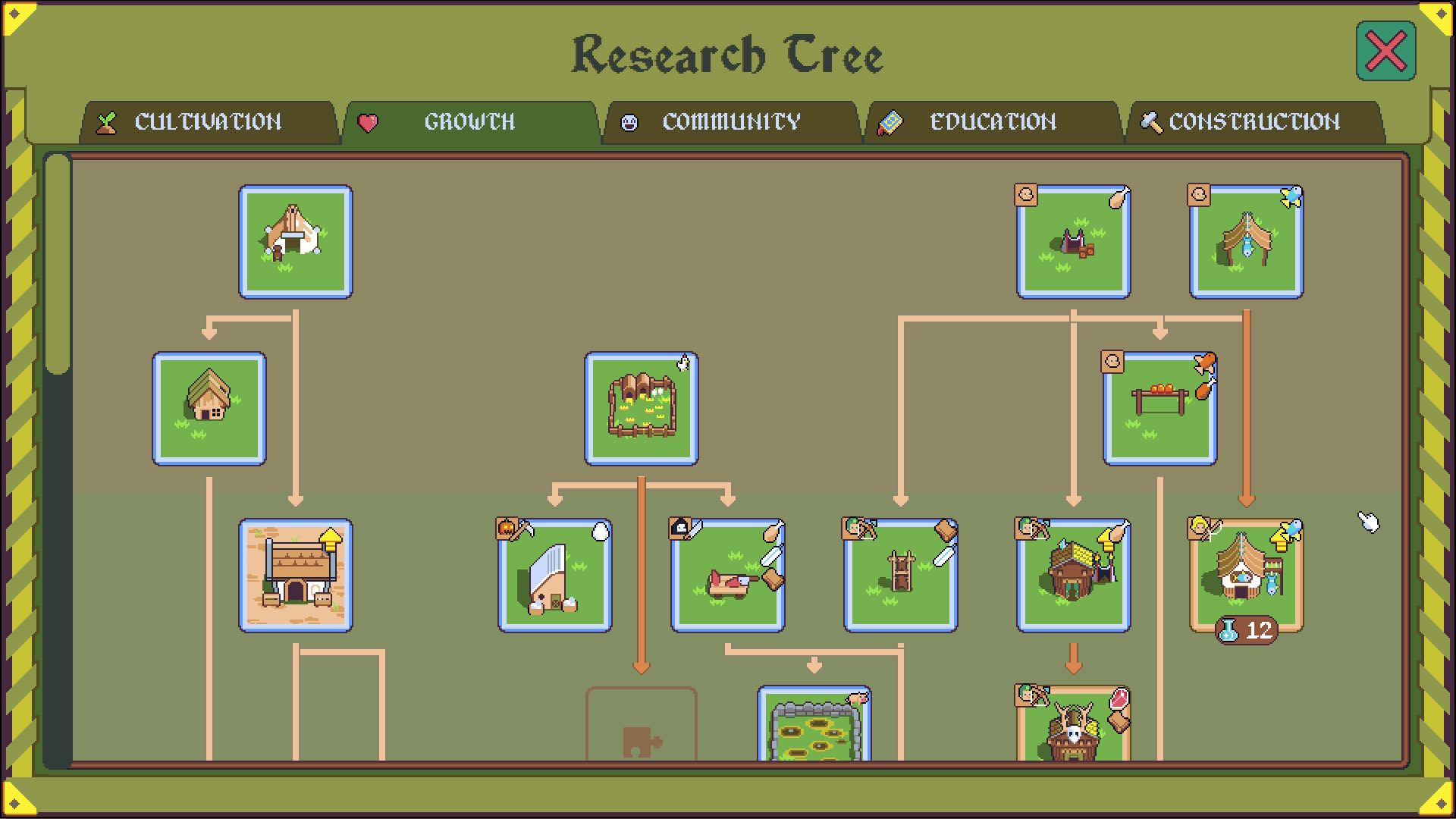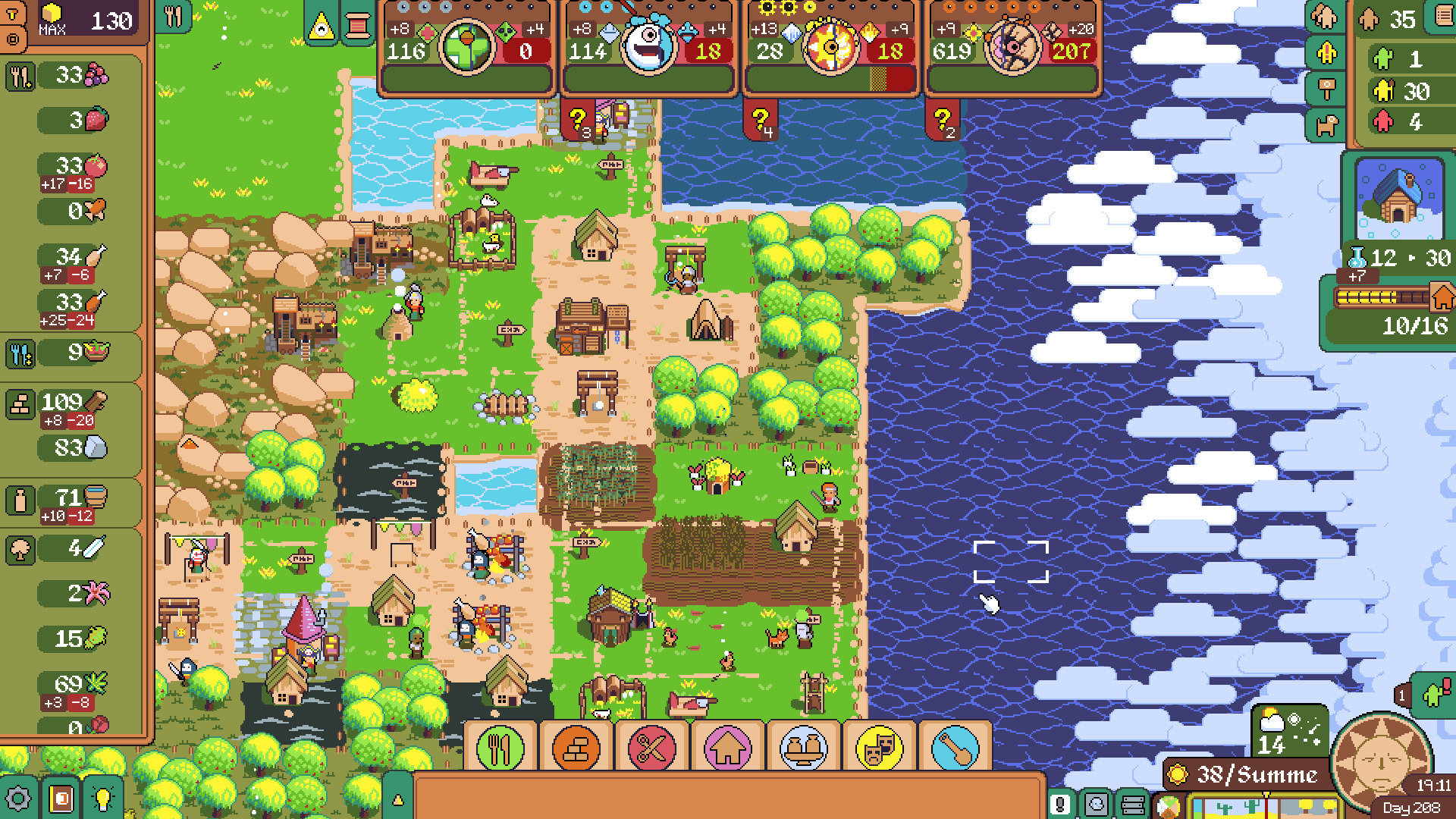dotAGE Review on Linux: A Brilliant Take on Strategy and Survival
I really enjoy reviewing the new Linux games coming out every single week. Sometimes I happen to stumble upon something that looks really cool, and with some persistence, we can usually get access to games we’d like to try. dotAGE is one of those! It’s mostly made by one person, Michele, from Italy, and extremely well designed. Don’t be fooled by the somewhat innocent pixel and cute appearance, this is a brutal game, yet very enjoyable.
Preparing for Doom
You play the role of the Elder of the village - settling with a few younger fellows referred to as “Pips” who settle in a new valley. It’s a turn-based game. In every turn, you get to decide how to allocate the occupation of your fellow citizens. At first, you build a bivouac, then a few houses. Since you have almost nothing at the beginning, you start to survive on picking berries and foraging.
Soon enough the Elder gets visions of Doom! In a matter of days, he predicts that a catastrophe is bound to happen. Some of these calamities are unavoidable and happen no matter what you do. Call it fate if you wish. Some other, usually graver ones, appear regularly and you can influence their outcome: such as turning a catastrophic event into a positive one. To do so, you need to produce some specific kind of goods: for natural cataclysms, building some altars to nature and praying in them sufficiently will progressively shift the likelihood of bad to good events. In the deep of winter, “cold” events appear and you can fight them by burning as much wood as possible in bonfires or the like. Your Pips can get afflicted by other kinds of calamities such as diseases, and producing remedies will shift the pendulum to positive health events.

At first, you only get one kind of calamity at once, leaving you time to prepare for it. As the game progresses, you will face a series of bad omens, putting more and more pressure on you to manage the production of specific goods (physical or immaterial) to fight fate. Despite what it seems, the core of the game is not really about fighting Doom, it’s about making your community expand and thrive while fighting the odds.
Resource Management
dotAGE shares some similarities with 4X games like Civilization: you need to ensure your community produces enough food and housing to continue expanding. But the focus here is microscopic, not macroscopic. You do not manage a nation, but a village and the game remains at a much smaller scale. I find it much more pleasant and plausible, since the mechanics make a lot more sense strictly speaking. You make your population grow by asking two Pips to make a baby together, and it works reliably (regardless of their sex!). There are some other inconsistencies such as animals being able to reproduce even if they are alone in your town, but this is just a matter of keeping the mechanics fun enough by allowing some flexibility.

One of the main challenges in the early part of the game is to survive. Food production is very tight until you reach some kind of decent agricultural level, and in my first game I lost all my Pips after being struck by a disease, rendering a few of my Pips unable to work for several days. Which meant a deficit of food. Which meant hunger. Funnily enough, Hunger does not kill your Pips (at least not until you reach some kind of late game stage) but it massively increases the production of… Fear! And high levels of Fear will lead to new series of bad omens and catastrophes that you won’t be able to prevent because you are too busy trying to scrape enough food to live another day. It’s a death spiral, and it works very well by triggering some Doom events instead of just a mathematical count of dead people. It’s even more stressful because you see the bad outcome coming your way - as if you had time to observe the huge tsunami wave that’s about to crash on your shore.
A Way Out
I am still in my second game after about 10 hours in dotAGE. This time, I applied sound economic principles: Economic growth is mostly increasing in a linear fashion with population growth (at least up to a certain point) and I decided to spend most of my hard earned resources into making more babies - after a few dozens days I had something like 15 Pips, which made not only my growth faster but also more resilient. I was hit a few times with calamities, but as long as only a few of my Pips were affected, this only had a small impact of the productivity of the whole enterprise. No show stopper. For a while the path to growth is fairly risky since you rely on a stringent management of food for a while until you get to critical mass with agriculture and hunting and domestication of animals.

All of this would be great and relatively easy were it not for the seasons in the game. While we nowadays live with comfortable means of life and are rarely impacted by survival issues in Winter, primitive folks surely had a much rougher time. In the game, Winters will stretch you to the limit of your settlement: food production will be cut in a very meaningful way. You rely on growing stuff? Too bad, nothing will grow in winter. You rely on berries? I’m sorry for you, berries don’t make it in the cold months. You like hunting? Sure, you will still find game to get some food, but your prey will reproduce much less and run out faster than you’d like. In effect, there are not a lot of good strategies to apply. To survive winters, you need to have something like a chicken pen, where you will keep a stock of animals and feed them before turning them into meat as needed. Then, raw meat will be transformed into cooked meat, more energetic, using barbecues. You will also be able to forage some food from the forests around your village. That’s mostly it. This means you need to dedicate a larger amount of your workforce for food gathering in colder months, and ensure you stock on food during the previous seasons to build enough buffer.
This also means that calamities will hit your even harder in Winters: since most of your Pips will be busy producing food, you won’t have as many resources available to deflect upcoming threats anymore. Compromises, compromises!
Early Days
The game has just been out for a short time, and some smart players have found out that they can hack it by having 100 Pips on the map. This was not something that the author expected and reading on the experimental branches he is planning to make it harder to sustain larger populations. I’m currently doing mostly fine with more than 30 Pips, I hope I won’t be too impacted by the upcoming adjustments.
Roguelike Elements
What makes the game stand out from other strategy games is the fact that you probably can’t manage to complete it in the first few games. Many aspects of the tech tree are obfuscated behind another tree that tracks the experience of the Elder. You start with an Elder that has kind of forgotten most of what happened before in previous villages, and has a blank memory state. As you successfully fight Doom events by turning them into positive ones, you gain some points that progressively unlock some of his memories, leading to stuff like:
- New buildings
- New Tech tree branches
- New events
- New relationships
- New elements added to the game (cats, pigs, strangers)
This, in turn, expands the space of possibilities in the game.

The tech tree is fairly extensive once you start unlocking things, and takes quite a long time to go through it. To unlock new buildings or technologies, you need to assign people to “think” in some remote areas away from the center of your village. This makes space management another challenge.
The Elder will *remember” what you have unlocked in previous games, even if you fail. This means that you start each new game with slightly betters odds to make it and less effort to access advanced tech. I like the fact that it’s not just “unlocked” but they use a plausible explanation by having the Elder surviving every game and therefore accumulating knowledge.

Another cool invention is a non-static tech tree. In dotAGE the tech tree is slighly reshuffled in every new game, so that the requirements and dependencies vary a little vs your previous game.
Space Management
The valley is fairly small in size - the map is far from infinite. At first you are limited to a few squares around your bivouac that can be reached and modified for different purposes. If you want to expand beyond, you need to build some signposts at the periphery - each of them will give you access to another array of blocks that you can use for various purposes. But soon enough you will run out of space. This is where tech upgrades becomes a renewed priority to improve the effectiveness of your current facilities without expanding on new space.

Some events will punish you for expanding too far as well. Fires will ravage through your settlements surrounding forests. Floods will destroy builds too close to the shores. Rocks will form next to existing mountains and destroy buildings that were too close. As you see, you just need to ensure you always have enough buffer so that none of these events bring you too close to breaking your existing production flow.
Just pure fun
The game loop is extremely addictive. That’s precisely why I was able to spend 10 hours on this in a fairly short time: it definitely has the just one more turn trick that makes 4X games click. The fact that you constantly face threats and need to fight them off is extremely stimulating and rewarding, maybe even more than just regular management games where such elements are not as consistently spaced out.
Beating one game can probably be done in 10~15 hours - In my second game, I am currently in the 5th era and I believe there are just 2 more left before reaching the eventual end of the game, based on the predictions of the Elder. Even if you finish the game, there are harder levels of difficulties to try out, and probably a lot more things you can try in a new playthrough as the tech tree expands over time.
One important detail: the game saves automatically when you quit, and there is no concept of save states that you can reload to go back and fix mistakes. The concept here is rather than you have to live with your mistakes, make the best of the current conditions you live with, or decide to terminate your current settlement and start from scratch again. In my time on the game so far, I have never felt that I wanted to reload a prior state. One of the reasons for such a design is that it could be used a hack to avoid bad events. You see, when a bad event is about to occur, you can produce some specific quantities of certain things, as explained earlier, to counter such events. If you are very successful at it, you will end with reversing the probability of a bad event to 0% and get a positive outcome instead. However, you can also end up in between, with, for example, 60% probability of a bad event to occur. The game lets you roll the dice so to say, in such situations, to find out whether you get a bad or positive outcome based on the current probabilities. As you can imagine, it would be very easy to check the result, reload the previous saved game, and retry the dice roll until you get a positive outcome. That would completely break the whole logic behind the calamities, so I think this is the right choice to avoid save states.
Steam Deck
One more word. The game works fine on the Steam Deck as well - typically I spend most of my time on the Steam Deck these days, but dotAGE is going to an exception. The interface is kind of hard to read and use on the Steam Deck and you’d benefit from a larger screen and a proper mouse. Things may improve down the road, but right now it’s probably not the best platform to enjoy dotAGE.
What’s Next?
The game is undergoing many improvements and bug fixes and it looks like it’s getting a very serious following. You will probably hear about dotAGE again, and the game may continue to be developed for a long time since there is such a strong interest. I know that I plan to spend a lot more time on it.
You can grab dotAGE on Steam any time and it even comes with a demo. It works fine with its native Linux client. As mentioned at the beginning, we have received a review key for this article from the developer.
